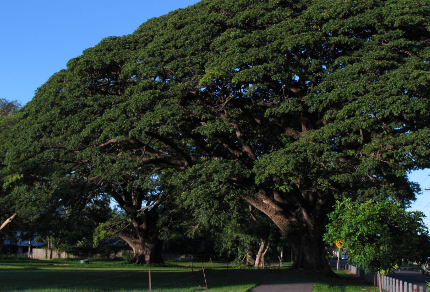
Rain Trees in Rosslea, Townsville (© Magi Nams)
In the early morning light, when I set off from our new residence to sample the birding in Rosslea, it seemed as though giants guarded the corner of our street. One was a huge paperbark tree shedding wide, ragged strips of bark from its trunk, and the others were my storm trees of last night, their spreading boughs kinked with many bent knees. On the opposite side of the street, two evergreen frangipanis – lush but not giants – dropped fragrant, white blossoms onto the pavement.
I heard the lovely, nagging ladies of the golf club – the little corellas – chiding anyone in sight from their perches in trees and saw them winging with slow beats above the vivid grass. Rainbow lorikeets fussed and argued in a spreading tree with pea-like, divided leaves, long seed pods, and fluffy, yellow blossoms. Within the tree, which draped its weeping branches over the sidewalk, a noisy friarbird with a black, bare head skulked among low branches, its grey shoulders hunched, its demeanour completely opposite to that of the high-spirited lorikeets. Brown honeyeaters, blue-faced honeyeaters, magpie-larks, house sparrows, masked lapwings, and a male figbird all added their voices to the morning symphony. In a yard opposite the golf course, yellow-throated miners with striking yellow beaks, eye-patches, throats, and wing patches plunged their beaks into a shrub’s bright red blossoms. A pied butcherbird with the black hood of a hangman landed on a dead tree, and crested pigeons with red eyes and upswept topknots of feathers preened on overhead wires. I could have birded for hours, but instead returned to the house for breakfast and a good-bye kiss from Vilis, who was off to James Cook University until suppertime. A new episode in our Australian life had begun.
Much later in the day, Vilis and I smelled bushfire smoke carried on a southeast wind, and Vilis told me he had smelled it at the uni, too. The acrid smell accompanied us, burning my throat while we strode the sidewalk edging the golf club and then headed down onto the sandy flats bordering the Ross River. We followed a trail through dense, low growth, the sandy path cluttered with the tracks of bikes and dogs. It led us to a cement bench perched on the bank above the river. A little nervously, I quipped to Vilis, “You can tell there aren’t any deadly crocodiles here, because there wouldn’t be a bench if there were.” “Just freshwater ones, and they won’t hurt you,” he reassured me.
When dusk deepened, we left the river and walked the golf club, Vilis collecting two coconuts fallen onto the mowed grass.“There are lots of them,” he told me, indicating a pile of the greyed husks that had been collected and tossed into a rough area beside the course. “I wonder how often they fall on people?” We agreed that falling coconuts would not count among the golfing hazards on Canadian golf courses.
The green swales of the course dipped and rolled gently in the darkening air. We shared them only with with lapwings, whistling ducks, and a woman walking her two dogs. “The bats are late,” Vilis told me after glancing at his watch. A crescent moon lit the sky, perhaps delaying the bats in their exodus from camp. Australian flying foxes are almost exclusively night foragers, leaving their camps at dusk or close to it.1 Their exact departure time appears to be influenced by the distance they must fly to available food.1 If food is far away, they may leave camps before sunset; if it’s close by, they’ll take to the air after dark.1 The phases of the moon also play a role in determining the bats’ flight schedules, a full moon keeping them in camp until long past sunset.1
Eventually, we noticed a single bat in flight, and then many more, some circling above our heads. Their chunky, furred bodies seemed stubby when compared to the long-tailed bodies of birds, and their small hind feet dangled at the edge of skin membranes that extended between hind legs and forelimbs. Their long muzzles were clearly visible, resembling those of their namesakes. And their wings, those spans of skin stretched between the greatly elongated fingers of their ‘hands,’ pumped in stiff, powerful beats. They certainly fit the name given to the suborder of bats to which flying foxes belong, the Megachiroptera or ‘big hand-wings.’
Vilis waved to the woman walking her dogs and called out a hello. She responded with a hello, and later, when we came close, asked if we’re looking at birds. “And the bats!” Vilis told her excitedly. “They’re pretty amazing, all right,” she responded.
She and we left the golf course at different entrances, but Vilis and I noticed the woman with her dogs ahead of us on the last block home. She crossed the street, sank into the shadows beneath tall trees, and turned into the gate next to ours. Unknowingly, we’d met a neighbour.
Reference:
1. Leslie Hall and Greg Richards. Flying Foxes: Fruit and Blossom Bats of Australia. 2000. University of New South Wales Press Ltd, Sydney, pp. 59, 66.


